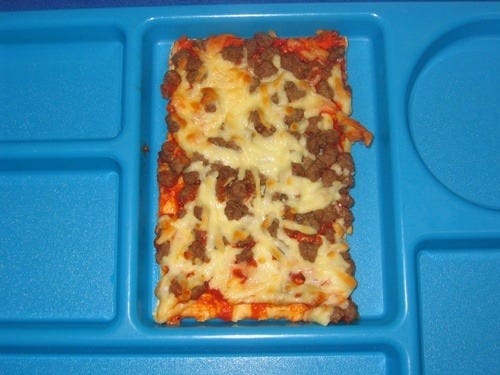Unnecessary Context
How I used to eat and how I stumbled into the world of fad diets and food snobbery
One day I’ll either write a reusable intro paragraph or give up and write a fresh paragraph of housekeeping notes every week, but for now I’ll start with another housekeeping note I didn’t plan on writing. I stayed up too late writing the last post, and by the time I finished I was in no state to notice the tiny radio button for choosing who would receive the post by email. It defaults to paid subscribers only, which is the middle option, which is therefore silly, but oh well. I didn’t notice and only sent this out to a few people. So if you missed the last post, you can read it here. But ANYWAY…(h/t Chuck Klosterman)
I’m very fortunate to have been raised in a home where almost every meal was cooked by my Mom–including lunch. We were homeschooled until high school, so we were allotted a reasonable amount of time for lunch and my Mom would make us hot ham and cheese sandwiches or some other yummy hot plate. I remember the shock of my first high school lunch, unpacking my giant bag of food only to realize I had just a half hour to consume all of it. But I loved my big lunch: sandwich, chips, fruit, and some delightful Little Debbie something-or-other for dessert, lovingly/begrudgingly packed just for me. So I never asked my Mom to pack less food, I just learned to eat faster.
Most of my school friends ate some sort of science pizza rectangle they got from the cafeteria every day for lunch. I was surprised and sad that they ate that shit every day. You’d think I would have been way better at sports than I was because I was eating so well before practice. But that didn’t pan out; I blame Twinkies. That was one of my first experiences of food that was lower quality than fast food, and one of the first times I realized how lucky I was to have a Mom that actually cared about what I ate.

We also didn’t eat at restaurants often and we didn’t keep a ton of junk food around the house. That’s not to say we ate only healthy food, or that when we went to restaurants we only ate at farm-to-table local spots. When I was a kid, “farm to table” wasn’t actually officially a thing yet.
I’m the oldest of five kids, so most of the time the food we were eating could be prepared somewhat quickly and in large quantities. It was always delicious and well-balanced, but it wasn’t complicated. When we did go to restaurants, we went to places that prepared their food quickly and in large quantities, too.
I don’t think kids have any concept of eating for nutrition or eating for health. They just want food that tastes good. I never asked my Mom if Burger King was what we should be eating, I just ate it because we were there and Whoppers taste good. I did notice that if I ate at my house I could usually get seconds and got really full, whereas at restaurants I usually could not get seconds and didn’t get full.
(Is “seconds” a Southern phrase? I don’t know.)
Fast forward to college: I was away from Mom’s cooking and hadn’t bothered to ask very many questions about how to feed myself before I left. Armed with a meal plan at the cafeteria, I fed myself whatever they had that day, and my class schedule didn’t always line up with eating at regular meal times, and finding time for three meals a day seemed like too much effort. For the first time my diet was filled with primarily starches and lots processed foods.
I didn’t handle the change well and actually lost the ‘Freshmen 15’ instead of gaining it. The weight loss was maybe due to eating exclusively unhealthy food, but just so we’re clear I was also smoking pretty heavily and had just discovered coffee.
Let’s talk about coffee. There are people who don’t drink it, meaning there are people that could have superpowers but are choosing not to have them. I was one of those people until college. A friend introduced me to coffee in the form of a caramel macchiato on the day of an exam; I felt like I was writing so fast that the paper was going to catch fire. I finished the exam before everyone, felt like a champion, had one of the best cigarettes of my life after, and aced the exam. I’d been opting out of this wonderful experience for eighteen years because (to my earlier point) coffee tastes bad. Then I discovered this cheap magical bean water is available everywhere and you can make it yourself. If you don’t drink coffee, stop being weird and start immediately. Objectively speaking, coffee probably does taste bad but I’d like to suggest that doesn’t matter in this case and if you just keep drinking it at some point you’ll convince yourself that it tastes very good. Or your palate just gets kind of burns out when you’re older and you start loving coffee because it’s bitter and makes things that are too sweet more palatable.
After I moved off campus, the meal plan didn’t make sense anymore. Now I had a kitchen, and asked my mom to send me a few simple recipes I could make myself. She bought me a sheet pan, a 13x9 baking dish, two skillets, a knife, and one of those electric griddle things. At first, everything I cooked came out of a box or a can and I only used the cookware to heat things. Once sophomore year ended, I stayed at my apartment to keep my job on campus and had lots of free time to practice cooking.
To more clearly define my idea of cooking at this point, I’ll walk you through a meal I ‘created’ based on one of my favorite menu items at a sports bar in my college town. Here’s the recipe:
College Calvin’s Buffalo Chicken Quesadillas
- 1 bag of frozen buffalo-style Tyson chicken tenders
- 1 bag of flour tortillas
- 1 bag (at least 16oz) of shredded cheese - feel free to mix it up here, “Mexican Blend” or “Mild Cheddar” were my go-tos
- 1 bottle Ranch dressing
Cook chicken tenders according to package directions. When finished, chop up chicken tenders directly on the countertop into small pieces. Fill tortillas with chicken and cheese. Place overstuffed tortillas on electric griddle until cheese is melty or the smoke alarm goes off, 2-3 minutes. Remove with slightly melted plastic spatula. Serve immediately on paper plates with Ranch dressing. Suggested pairing: Coca-Cola or Keystone Light.
This level of cooking got me through college. When my wife and I were newly married and learning how to feed ourselves after working long days at new jobs, we cooked what we knew best: casseroles.
If there’s a term synonymous with ‘Freshmen 15’ for newly married couples, that’s what happened to me. Let’s call it ‘Honeymoon Husky’. Putting a can of Cream of Chicken in every dish then topping it with sour cream and shredded cheese is likely to result in weight gain. But this is what I knew how to cook, and at the time every recipe on Pinterest was a slow cooker this or a casserole that, and with that being my primary source of recipes that’s all I was making.
After eating this way for a few months and realizing that I had some issues with digesting all the cream-of-whatever atrocities I was making, we started to look for alternatives.
That’s when we found Paleo, Whole 30, and a host of other fad diets that transformed the way we ate (and the way we shopped). We learned a lot, but also had some serious questions after doing our research.
That’s enough words for now, so I’ll leave you with another essay to read between now and next time.
This week someone shared a delightful piece about how the pandemic caused the author’s standard mealtimes to devolve into what she calls “Big Meal”. But ‘devolved’ is probably wrong, because who says we’re supposed to eat three times a day just because industrialization?
